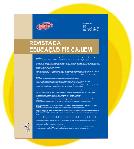Multicomponent physical activity program: study with faller and non-faller older adults
Abstract
Falls are considered a public health problem and physical activity is an effective strategy to prevent fall. The goal of this study was to assess the effect of a physical activity program on physical fitness, fear of falling and quality of life in groups of faller and non-faller older adults. Study was conducted with participants of a multicomponent program of physical activity at a university in Brazil. The participants were assigned to: faller (n=25) and non-faller (n=133) groups. Participants were assessed using the Senior Fitness Test, Falls Efficacy Scale-International Brasil and The Medical Outcomes Study 36. Mean, standard deviation, Student “t” test and effect size were conducted. There was a difference between faller and non-faller individuals at LLFLEX (p=0,05), LLS (p=0,04), BA (p=0,03), FES (p=0,00), SF36 (p=0,00). The group of non-faller elderly people improved physical fitness. The pre test of the faller group showed increased fear of falling in comparison to the non-faller group. The physical activity program did not influence fear of falling in any of the groups. The quality of life showed better results in the non-faller group, with variation in some aspects between groups and over time. Elderly people with a previous history of falls need a differentiated physical program.
Downloads
Copyright (c) 2019 Journal of Physical Education/UEM

This work is licensed under a Creative Commons Attribution-NonCommercial-NoDerivatives 4.0 International License.
• Authors retain the copyright and full publishing rights without restrictions.

This work is licensed under a Creative Commons Attribution 4.0 International License.









_1502.jpg)











